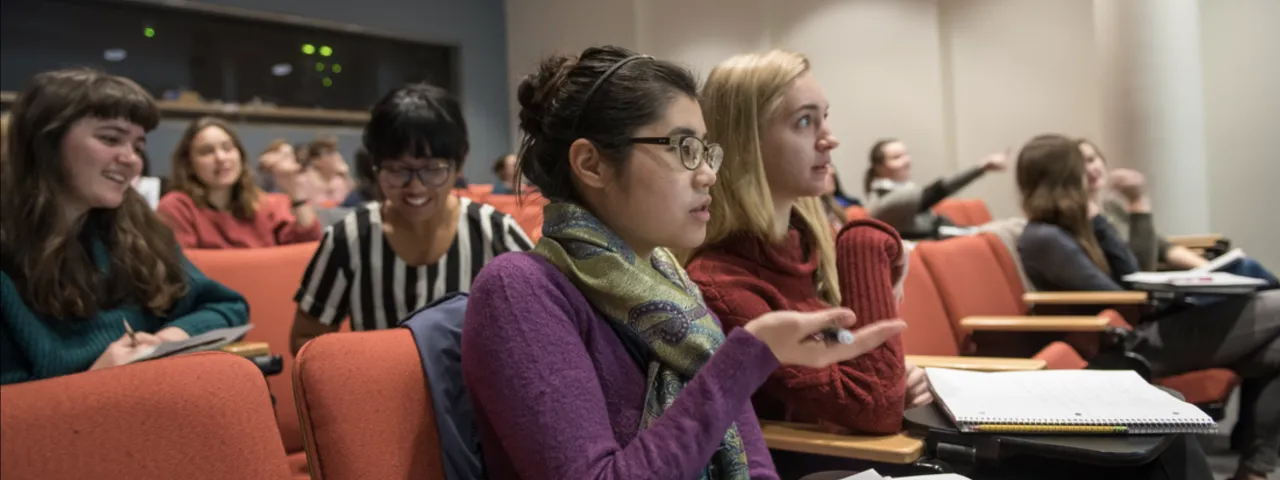The History of Art
Students in art history classes might focus on ancient ruins, European landscape painting or Japanese anime. Our classes place value on the study of original objects, and students at all levels make site visits and do research in museums. Whether a student is interested in East Asia or North America, Maya ceramics or medieval manuscripts, the art history program seeks to understand questions of visual literacy and the roles that art and architecture play in our present world.
Requirements & Courses
All graduating Art majors and minors will:
- develop familiarity with original works of art and/or architecture and with research tools appropriate for the discipline, including print scholarship, online databases, and various reference materials;
- communicate their ideas effectively in written, oral and (as appropriate) material form, including public presentations that rely upon the display of visual images or artwork;
- engage a range of disciplines in their work, in the spirit of a liberal arts education.
Art History majors and minors will:
- learn to read original objects, architectural settings, and written scholarship analytically and synthetically;
- demonstrate familiarity with the different ways that spaces, monuments, and objects have intersected with lived and imagined experiences throughout history and the world over;
- demonstrate expertise in self-directed research, including fluency with a range of methodologies and debates across the discipline.
Assessment: Students will be assessed in classes, through faculty reviews of their written and oral abilities.
Students will also complete a capstone research seminar that results in a sustained piece of original research to be evaluated by the faculty.
Advisers
Yanlong Guo, Barbara Kellum, Dana Leibsohn, John Moore, and Frazer Ward.
Courses in the history of art are divided into areas that reflect breadth in terms of both geography and chronology.
Requirements
Basic requirements:
ARH 110: Art And its Histories, or a First Year Seminar taught by an art history faculty member
ARH 190: Art History: Theory, Methods, Debates
ARH 390: Art History Capstone
One studio class
In total, the major requires 10 courses:
- As a gateway to the major, students may take either ARH 110: Art and Its Histories, normally to be completed by the sophomore year, or a First Year Seminar taught by an art history faculty member
- One class in studio art
- ARH 190: Art History: Theory, Methods, Debates, normally to be taken by the junior year.
- Six courses in the history of art and architecture at the 200 and 300 levels.
- Students are expected to take a mix of lectures, colloquia, and seminars, sequenced in consultation with their advisors.
- These classes should address a range of methodologies, time periods, and geographies (e.g. Asia, Europe, North America, Latin America, Africa, etc.).
- For different methodological approaches, students should take classes with a range of faculty members.
- The six classes should include two that focus on material created before 1850. Note that there can be overlap, so for instance a class on Buddhist grottoes could serve as both a class on material before 1850 and on Asia.
- In consultation with your advisor, these six classes may include one from a related discipline or a second studio class.
- ARH 390: Art History Capstone, required class normally taken in the senior year (in addition to the six classes listed above)
**In response to the current unprecedented circumstances, the Department of Art is allowing up to two Satisfactory/Unsatisfactory (S/U) courses from Academic Year 2020–21 to count towards the major.
**Students entering Smith College in the Fall 2023 semester (or after) are subject to the above requirements. All others have the option of following this set of requirements, or the one in effect when they arrived at the College or declared their major.
Advisers
Yanlong Guo, Barbara Kellum, Dana Leibsohn, John Moore, and Frazer Ward.
Designed for students who, although they major in another department, wish to also focus on the history of art. With the assistance of their advisers, students may construct their minor to be as specific or comprehensive as they desire within the skeletal structure of the requirements.
Requirements
Basic requirements:
ARH 110: Art And its Histories, or a First Year Seminar taught by an art history faculty member
ARH 190: Art History: Theory, Methods, Debates
In total, the minor requires six classes:
1. As a gateway to the minor, students may take either ARH 110: Art and Its Histories, normally to be completed by the sophomore year, or a First Year Seminar taught by an art history faculty member
2. ARH 190: Art History: Theory, Methods, Debates
3. Four classes in the history of art and architecture:
• Students are expected to take a mix of classes sequenced in consultation with their adviser.
• These classes should address a range of methodologies, time periods, and geographies (e.g. Asia, Europe, North America, Latin America, Africa, etc.).
•For different methodological approaches, students should take classes with a range of faculty members.
• The four classes should include one that focuses on material created before 1850. Note that there can be overlap, so for instance a class on Buddhist grottoes could serve as both a class on material before 1850 and on Asia.
• The four classes should include two at the 290 level or above.
• The four classes may include one studio art class.
**Students entering Smith College in the Fall 2023 semester (or after) are subject to the above requirements. All others have the option of following this set of requirements, or the one in effect when they arrived at the College or declared their minor.
Honors
History of Art Director of Honors: Frazer Ward
Every year the art department organizes an informational meeting about honors, an 8-credit class focused on independent research. We strongly encourage interested students to attend this discussion of important deadlines and the timeline for applications. The college’s official requirements, guidelines and deadlines are available on the class dean’s website.







